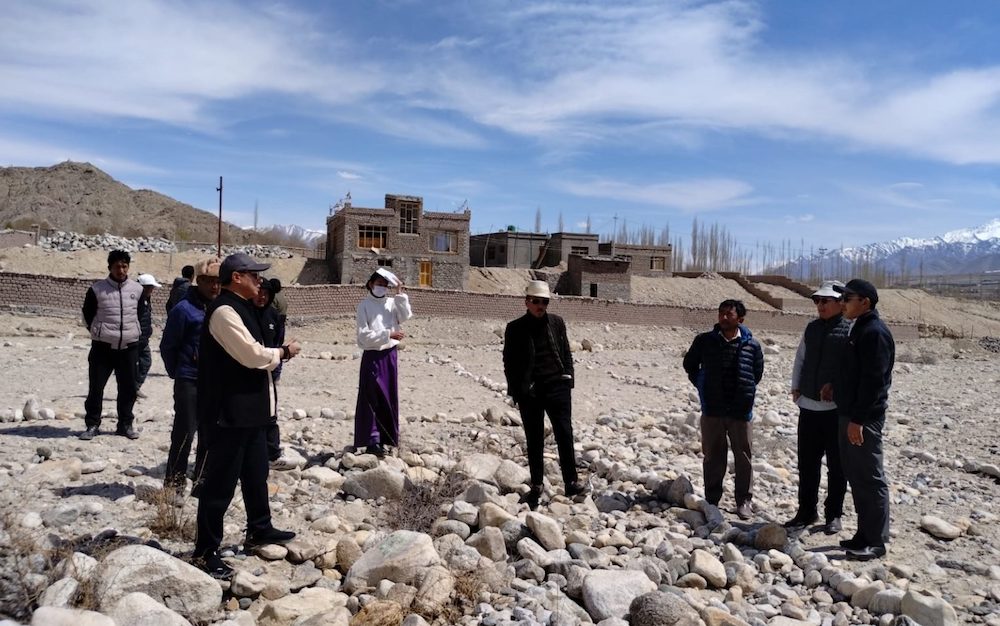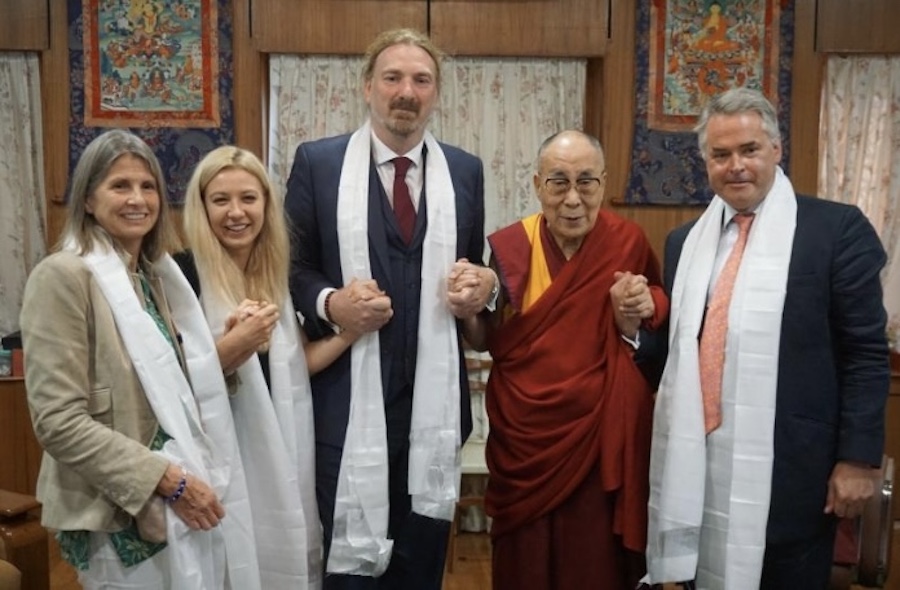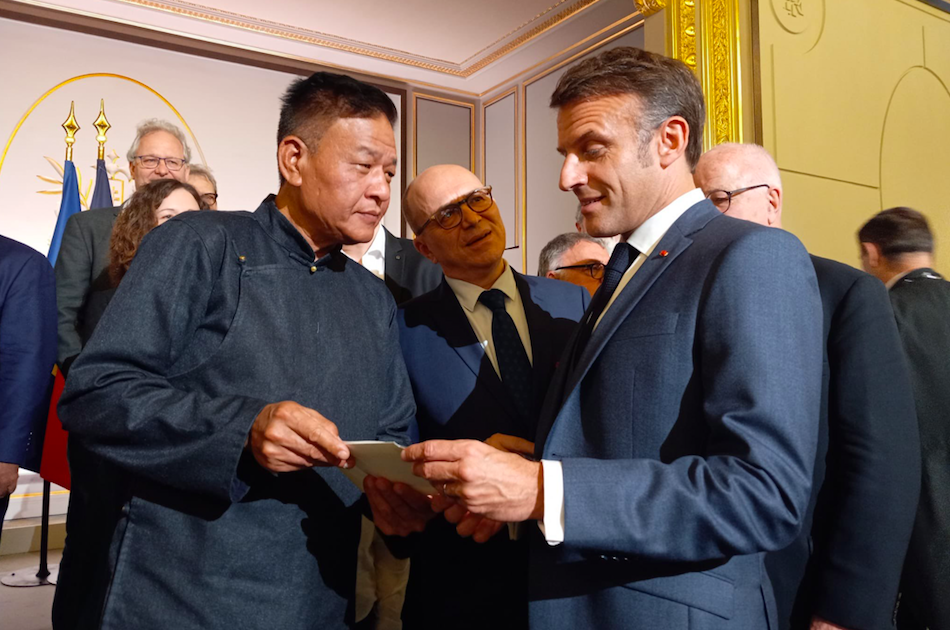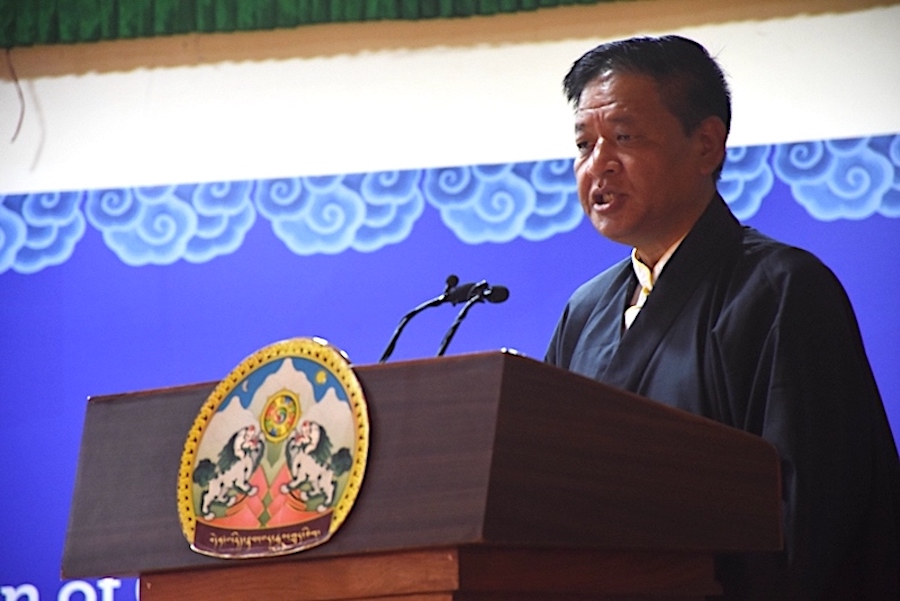“I think that between 2004 and 2006 there are lot more Chinese, Chinese taxi drivers mostly, big Chinese department stores, there is a huge difference and I think the way the brothels look is a lot more Chinese influenced…”
A photo exhibition by Sarah Schorr, an American Photographer at Gallery 9 in Kathmandu titled ‘Steel Butterflies’ depicts the lives of Tibetan  and Chinese prostitutes in Lhasa, capital of occupied Tibet. The sex workers depicted in the photographs are mostly in the age group of 15-35. In Schorr’s words, these places are ” salons and bars by the day” and “by night they are brothels for young prostitutes, with storefronts distinguished by glowing pink neon lights”.
and Chinese prostitutes in Lhasa, capital of occupied Tibet. The sex workers depicted in the photographs are mostly in the age group of 15-35. In Schorr’s words, these places are ” salons and bars by the day” and “by night they are brothels for young prostitutes, with storefronts distinguished by glowing pink neon lights”.
Schorr spoke to Phayul Correspondent in Kathmandu Tenzin Choephel about the growing prostitution menace in Lhasa and about her project to record these in her camera.
Phayul: What prompted you to take up this project?
Sarah: I had photographed women in the sex industry in New York city in the US. So, I was generally interested in this subject matter; how women happen to get in the situation and what draws them to it or is it usually a financial problem that leads them to to the situation.
P: And what is the purpose of doing this exhibition?
Sarah: I guess when I was in Tibet, I became very curious about what was behind these pink storefronts and so it was curiosity initially that led me to the project but it was the individuals who I met, who really got my interest because they were such interesting, very sweet young women and they seem to be stuck in that situation.
P: When did you first go to Tibet?
Sarah: I first went to Tibet in 2004. That was the time when I noticed it and I started to get ready to do this project but I took most of the photographs in 2006 this year around Losar in the winter.
P: Initially, did you take photographs from outside or did you go in directly?
Sarah: Well, initially I planned to just photograph the outside precincts. But one day I walked in and I was very compelled to talk to the women, they were so nice and warm and friendly and they seem like they wanted to talk to someone and they wanted to be photographed.
P: How many brothels did you visit?
Sarah: I went to about 10 or 15 repeatedly but I saw more than that in my time, but I would generally go to the same 10 or 15 to really start a relationship with particular women.
P: Are there more Chinese or Tibetan prostitutes?
Sarah: These photographs in the room here are only a small part of the project. On the whole, it is about half and half, and in the places that I saw were about half and half as well, although Chinese women were often older in age and the Tibetans often younger but about the same amount of both.
P: What do you think is the reason for the rise in prostitution in Tibet nowadays?
Sarah: I think that the prostitution is more apparent now because of Chinese influence in Lhasa specifically, and the presence of the pink lights seemed to be more in the Chinese brothels in particular, and so it is much more upfront even from 2004 to 2006, I saw an increase.
P: I have heard some of these prostitutes on the streets pull the customers in; did you see anything like that?
Sarah: There were some worst areas where women were on streets but generally the places that I went to, most of them operated from inside. So, they would be sitting in the windows and you just walk in. The Chinese places are easier to see from the street. But usually the brothels are lined up in such a way that it is a Tibetan brothel first, then a Chinese brothel next, then again a Tibetan brothel, or two Tibetan brothels and two Chinese brothels and so on.
P: So, the Tibetans do it in a separate way and Chinese do separately?
Sarah. Generally, yes, there is some overlap; some mixed within places. Normally, it is a whole Tibetan place and a whole Chinese place.
P: So, in a nutshell, prostitution is their profession?
Sarah: They are so young, its hard to call it, you know, it is their profession. It is how they make money but I think that there is hope that maybe it’s their way to get to Lhasa, get to the city from villages and maybe they will go on to something else, I mean, it generally seems to be their means to a better life hopefully or they think that.
P: What was the youngest age among them?
Sarah: The youngest age that I recall is age 15, and some of them maybe younger but I am not sure.
P: Did you document story of any girl in particular?
Sarah: There was a lot of language barrier between me and the girls, so I would often go with an interpreter, but the stories that I got specifically,were visual because a lot of what I was doing was observing them, like how they acted, when they were sad, when they seemed remorseful and when they seemed really excited and sort of happy to be with their friends.
P: Did you know where these girls mostly come from, any particular part of country?
Sarah: It was a mix, I would say it is pretty mixed but lot of them were from very small villages. There was a bunch from Shigatse, again they were lot of different towns.
P: Are these places just brothels or something else?
Sarah: Sometimes they are bars, sometimes they are hair salons, my friend tried a haircut but it didn’t come out good, so I think mostly brothels.
P: I heard that there are lots of bars, places ironically called ‘Nangma’,which are restaurant and bars cum brothels, is it true?
Sarah: I think ‘Nangma’ is fabulous, I don’t think it’s a bad thing, but I don’t know so much about ‘Nangma’ and that is a separate thing from prostitution, but you do see a lot of revealing clothing in that sort of situation and a lot more rock music and that type of thing, but I think it is separate thing from brothels, I am not sure, I was looking more at low end brothels.
P: I heard that the Chinese own most of these brothels and owners have good relation with leaders, did you know anything about that?
Sarah: I can’t comment on that, again I don’t know and there was some communication gap, I was less communicating with management of these places and more with girls who were sort of at the bottom level of the situation.
P: Any idea how much these girls earn per day?
Sarah: No, but I generally know they charge about 100 Yuan per customer, generally, of course it varies but that’s sort of average.
P: Are there lots of people going to such places?
Sarah: Yeah, a lot were going to them.
P: What about health and sanitation condition; do they have health check up or anything?
Sarah: This is something that I think is becoming more available but it is something that I would like to help with in the future. It is something that I hope these photographs would bring some awareness. There is a need for more counseling and education about sexually transmitted diseases.
P: There are lots of restrictions on things like photography in Tibet, how did you get permission, how did you do it?
Sarah: The reason that the prostitution is allowed to go on is because it goes in the same… I will explain in two things, one because these institutions are either hair salons or bars, so they have a license to be those institutions and they double their profits, and in terms of myself it was not hard, I experienced no difficulty in going into these places, no police presence at all.
P: Usually, when you try to tell something about Tibet, Chinese authorities would call you to try to stop you or intimidate you, did you get any such calls?
Sarah: So far I have not experienced this, my biggest fear is that I will have some trouble going back because I want to go back and continue.
P: What is your message to people through this exhibition?
Sarah: Less than telling people, I would want people to look at the photographs. Sometimes, subject matter like this is difficult to think about, we don’t like to think about the fact that some of the young women in our community are in these situations, but I want to, by looking at the photographs, I want you to consider these as individuals who need help and but also just, I think to look and think not all of them are same or in the same situation.
P: When do you plan to go back?
Sarah: As soon as I can, hopefully this year.
P: How is the situation in Tibet in general?
Sarah: I think that between 2004 and 2006 there are lot more Chinese, Chinese taxi drivers mostly, big Chinese department stores, there is a huge difference and I think the way the brothels look is a lot more Chinese influenced but again I personally don’t think this problem just started in the last few years and I think it’s a problem that every country experiences, so its not unique to Tibet.









